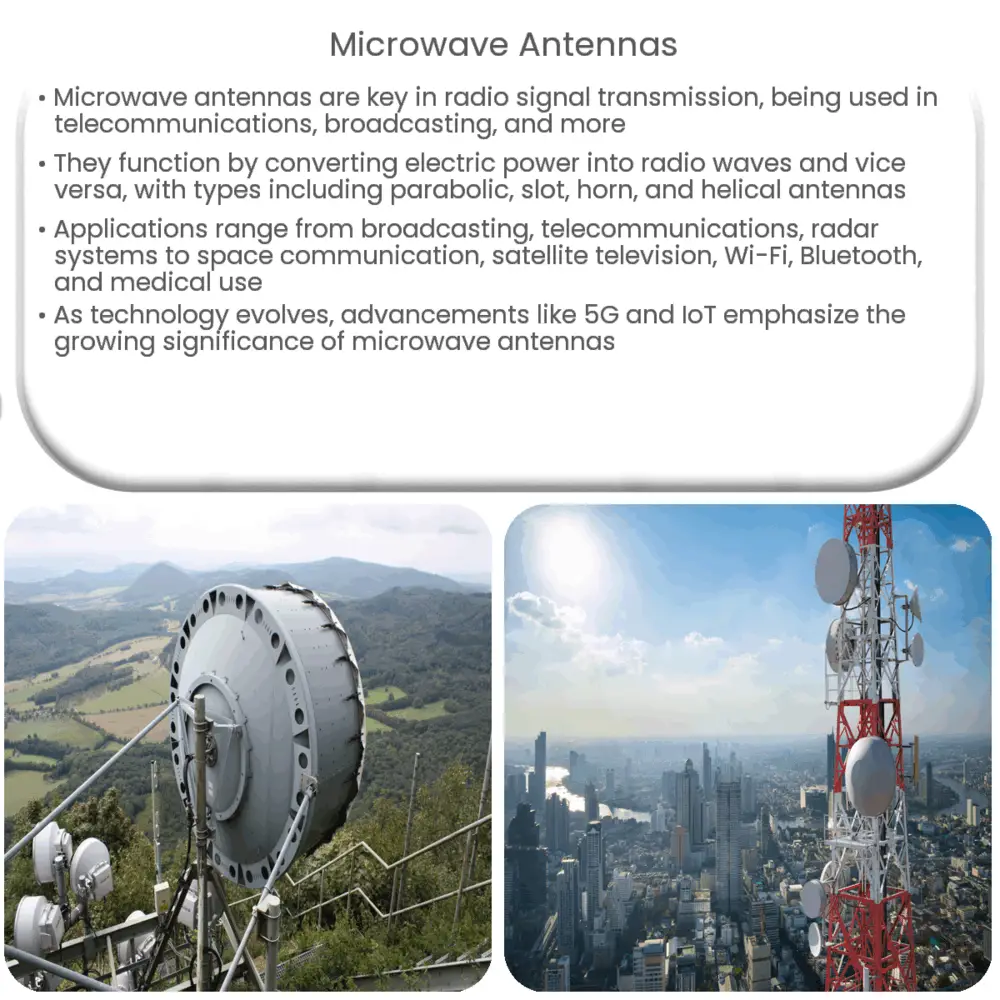Explore the world of microwave antennas: their structure, types, and diverse applications in broadcasting, telecommunications, and future technologies.

Microwave Antennas: An Introduction
For many people, microwave antennas might be an unfamiliar concept. However, their crucial role in the world of telecommunications and broadcasting technology can’t be overstated. These specialized antennas are pivotal in radio signal transmission, playing a significant role in many aspects of our day-to-day life. In this article, we delve deeper into the world of microwave antennas, their structure, types, applications, and much more.
Understanding Microwave Antennas
Microwave antennas, fundamentally, are devices designed to transmit or receive microwave signals. These signals are part of the electromagnetic spectrum, with wavelengths ranging from one meter to one millimeter; frequencies between 300 MHz (0.3 GHz) and 300 GHz.
Structure and Functioning of Microwave Antennas
Microwave antennas are typically constructed with metal conductors and arranged in specific configurations that allow them to effectively radiate microwave energy into space or receive it. These antennas function by converting electric power into radio waves and vice versa. A transmitter is connected to the antenna which generates an electric current, causing the antenna to radiate this energy as electromagnetic waves. Conversely, when the antenna receives electromagnetic waves, it generates a current which the receiver can interpret.
Types of Microwave Antennas
- Parabolic Antenna: Also known as a dish antenna, this type of antenna is used to transmit or receive signals in a specific direction. Its parabolic shape allows it to focus the electromagnetic waves in a particular direction, making it highly effective for point-to-point communication.
- Slot Antenna: These antennas are often used in radar systems and have an opening or ‘slot’ cut into a plate that acts as the antenna’s surface.
- Horn Antenna: This antenna resembles the shape of a horn, hence its name. It is used for short-range microwave signal transmission and is commonly used in laboratories for testing microwave systems.
- Helical Antenna: Characterized by its spiral structure, it is used predominantly in space communication, where its circular polarization can be used for satellite and wireless communication.
In addition to these, there are many other types of microwave antennas, each suited for specific applications. The selection depends on factors such as the required range, directionality, signal strength, and more.
Applications of Microwave Antennas
Thanks to their wide frequency band and high-speed data transmission capability, microwave antennas find applications in various fields. Some of the key areas include:
- Broadcasting: These antennas play a vital role in radio and television broadcasting, allowing for the widespread dissemination of signals.
- Telecommunications: Microwave antennas are integral to mobile networks, facilitating efficient wireless communication.
- Radar Systems: Radar systems rely on these antennas to transmit and receive radar signals, integral to air traffic control, weather monitoring, and defense applications.
More Applications of Microwave Antennas
Expanding further on the applications of microwave antennas, they are used in:
- Space communication: As space communication requires long-distance transmission, microwave antennas, especially the helical and dish type, are ideal due to their directionality and high gain.
- Satellite Television: The direct-to-home television services use dish antennas to receive television signals directly from communication satellites.
- Wi-Fi and Bluetooth: The wireless devices we use every day like mobile phones and laptops employ small microwave antennas for Wi-Fi and Bluetooth communications.
- Medicine: Interestingly, in medical field microwave antennas are used for certain diagnostic and therapeutic applications, including hyperthermia treatment for cancer.
Microwave Antennas and the Future
As technology continues to evolve at an ever-increasing pace, microwave antennas are expected to adapt to these changes and enhance their capabilities. Emerging technologies such as 5G communication and the Internet of Things (IoT) rely heavily on effective signal transmission, emphasizing the continued importance of microwave antennas. Additionally, innovations in antenna design, such as fractal and smart antennas, are opening up new avenues for more efficient, compact, and high-performance microwave antennas.
Conclusion
In conclusion, microwave antennas, though often overlooked, are pivotal elements in our increasingly interconnected world. From broadcasting to telecommunications, space exploration to medical applications, they form the backbone of many technologies that we rely on daily. Understanding the functionality, types, and applications of microwave antennas equips us to appreciate the complexities involved in signal transmission and the technology that enables it.
As we move towards a future characterized by even greater connectivity and wireless communication, the role of microwave antennas is set to become even more significant. Hence, continuous research and development in this field are of paramount importance to keep pace with our growing demands for data and connectivity.

